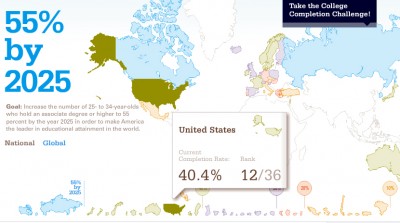Recess round-up: July 27, 2010
A daily dose of education news around the nation – just in time for a little mid-day break!
Race to the Top: Round Two finalists were announced today by Secretary of Education Arne Duncan. Meanwhile, Nick Anderson of The Washington Post writes that President Obama’s education agenda is hitting a wall in Congress. Stay tuned for The Hechinger Report’s interactive map to see how much money each finalist could win. (Department of Education and Washington Post)
Charter schools: In light of the state budget crisis, a new report from the New Mexico Legislative Finance Committee recommends cutting funds for existing charter schools and temporarily halting the approval of new charters. (New Mexico Independent)
Common standards: While 30 states have now adopted the Common Core State Standards — Florida did so today — there’s an ongoing debate about the new standards. (Orlando Sentinel and National Journal)
D is for delete: A northern New Jersey school board eliminated the “D” grade for middle and high school students, making 70 the cut-off point for a failing grade. (AP via The [Newark, N.J.] Star-Ledger)
Evaluating teachers: In Buffalo, after three years, the teachers’ union and public schools have developed a more thorough annual evaluation process that requires principals to provide support for struggling teachers. (Buffalo News)
Research/Child well-being: The Annie E. Casey Foundation 2010 KIDS COUNT Data Book includes rankings on 10 key indicators of child well-being. (The Annie E. Casey Foundation)
Research/Financial aid: With college enrollment up, demand for financial aid is also on the rise. In 2008-2009, states awarded about $10.3 billion in financial aid, up from $10 billion the year before. Yet, financial aid rules are still complicated, a fact that leads some students not to apply. (National Association of State Student Grant & Aid Programs and The Chronicle of Higher Education)
Recess round-up: July 26, 2010
A daily dose of education news around the nation – just in time for a little mid-day break!
Assessing the tests: Critics say New York City has awarded teachers and principals millions of dollars in bonuses, and ranked schools based on “phony” test scores. Meanwhile, others say it’s too easy for teachers to teach to the test. (New York Daily News and The New York Times)
Portable classrooms: South Florida schools are getting rid of portable classrooms. Such classrooms were once the answer to surging enrollments, but regional growth has slowed and school enrollments have declined. School districts are deciding what to do with hundreds of portables they no longer need. This isn’t the first time portable classrooms have been controversial. What might classrooms of the future look like? (The Palm Beach Post News, The Educated Reporter and Open Architecture Network)
Mobile technology in the classroom: With instruction from Apple, AT&T and Verizon representatives, Northeast Mississippi teachers learn to use cell phones, iPods and iPads in their classrooms. (NEMS360.com)
Graduation rates: Different calculations on the number of dropouts in Texas’ public schools. (San Antonio Express-News)
Civil rights and education: “Seven civil rights groups, including the NAACP and the National Urban League, called on U.S. Secretary of Education Arne Duncan today to dismantle core pieces of his education agenda…” The National Opportunity to Learn campaign issued an education policy framework that includes suggested changes to the blueprint for reauthorizing the No Child Left Behind Act, also – and originally- known as the Elementary and Secondary Education Act. (Education Week)
Higher ed: With only 40 percent of its young-adult population (ages 25 to 34) holding college degrees, the United States has dropped to 12th in the world. (The College Board)
Race to the Top: Will Ohio be a finalist? Round Two finalists will be announced tomorrow. (Dayton Daily News)
UPDATE (July 29, 2010 11:45 a.m.): Michele [McNeil at Education Week] just talked to the Rev. Al Sharpton, who was originally on the press release as a supporter of this new framework. He told her that the critical framework was “prematurely released” and that his National Action Network, the NAACP, and the Urban League, are actually not supporters of the framework. He added that these three groups didn’t have “concerns” about the President’s education agenda, but “questions,” which were addressed in a Monday meeting with administration officials. In fact, the Rev. Sharpton said, “I agree with [the president]…I’m prepared to fight for a lot of what he’s saying.”
When should a leader apologize?
To apologize or not to apologize, that is the question. It’s not quite the question Hamlet asks himself, but it is a question facing leaders on a regular basis. When is an apology necessary? When might it actually do more harm than good? And why does it seem like leaders are apologizing nonstop nowadays?
These are some of the questions that Barbara Kellerman, of Harvard’s Kennedy School of Government, and I tried to tackle in a recent interview on the BAM! Radio Network. Kellerman is the James MacGregor Burns Lecturer in Public Leadership at Harvard, and she wrote an interesting article entitled “When Should a Leader Apologize — and When Not?” that appeared in the April 2006 issue of the Harvard Business Review. In the article, Kellerman says that “leaders are prone to overestimate the costs of apologies and underestimate the benefits.” Interviewing the two of us was Holly Elissa Bruno, a host on the BAM! Radio Network.

Pope Benedict XVI (photograph by Torvindus)
I argued that shifting cultural expectations have led us to expect public apologies more often than in the past, even from people we long thought infallible — like the Pope. The Teflon exterior that some leaders assume in the face of disasters or embarrassments can be counterproductive and even backfire, as it did with Larry Summers during his tenure as Harvard’s president. A timely and sincere apology, I suggested, can cover a multitude of sins.
Kellerman pointed out that apologies have become so prevalent largely because technological changes allow us to witness the debasement of people, as well as to reveal our inner selves — “our secrets and scandals” — in new ways to mass audiences. She called this the “Oprah-ization” of our culture.
Kellerman also suggested a framework for apologies — five questions leaders should ask themselves before rushing to apologize: 1) what function would a public apology serve?; 2) who would benefit from an apology?; 3) why would an apology matter?; 4) what happens if one apologizes publicly?; and 5) what happens if one doesn’t apologize?
These are great questions that I’d bet most leaders never think to ask themselves.
One leader who never apologized was Claudius, the fictional king of Shakespeare’s Hamlet who wins the throne by killing his brother, Hamlet Senior. The closest he comes to an apology is his attempt at prayer in Act III, Scence 3, but it’s directed at God, not the title character:
O, my offence is rank it smells to heaven;
It hath the primal eldest curse upon’t,
A brother’s murder. Pray can I not,
Though inclination be as sharp as will:
My stronger guilt defeats my strong intent;
And, like a man to double business bound,
I stand in pause where I shall first begin,
And both neglect.
Moments later, Claudius realizes that apologizing to a divine being is pointless because he’s unwilling to give up what he’s gained by murdering Hamlet Senior. He briefly wonders, “May one be pardon’d and retain the offence?” The answer, of course, is no. Apologies are guaranteed to fail when they aren’t sincere and when wrongs aren’t righted.
Recess round-up: July 23, 2010
A daily dose of education news around the nation – just in time for a little mid-day break!
Education entrepreneurship: University of Pennsylvania’s Dough Lynch wants to “create one of the nation’s only business incubators dedicated to education entrepreneurs.” (Associated Press)
Student pass rates: Texas Education Commissioner Robert Scott defended a formula that lets schools count students who fail the state’s standardized test as having passed “if the projection measure shows they are likely to pass in a future year.” (Dallas Morning News)
College completion: The College Board released a new report with 10 policy recommendations to achieve a goal of having 55 percent of Americans aged 25-34 with postsecondary degrees by 2025. (DiverseEducation.com)
But in a new survey, only 63.5 percent of Americans “said a college education is still a good financial investment for young adults given rising costs,” down from about 79 percent last year. (Wall Street Journal)
Teacher evaluations: The Virginia Department of Education is looking at how the state’s teachers are evaluated and considering a move to tie teacher compensation to student performance. (WDBJ7.com)
What can you get with $100? In New Jersey’s Hillsborough school district, that might soon be the price tag to participate in a high school extracurricular activity. (NJ.com)
Or, in some teachers’ unions, that’s how much is spent per member on political campaigns. (Education Next)
Reversing lagging U.S. college completion rates: What will it take?
There was a time when the U.S. could boast it had the highest percentage of its adult population aged 25-34 with college degrees, but it’s been a long time since anyone could make that claim. Lately, there’s been a great deal of attention focused on the need to ramp up the number of college graduates, and a report released on Thursday by the College Board came with a statistic that is intended to create alarm: We are now twelfth.

Click on the map to see how the U.S. stacks up against the rest of the world with the College Board's interactive graphic.
The lagging college graduation rates have not gone unnoticed by President Barack Obama, who has repeatedly called for more Americans to get postsecondary degrees, including an additional five million community college degrees and certificates by 2020 via his American Graduation Initiative. The low number of college graduates is worrisome at a time when there’s a wide disparity in the skills needed in a tough economy vs. the number of workers who have the education and training to fill them, according to a report released earlier this month by the Georgetown University Center on Education and the Workforce.
Last week, governors joined the college-completion chorus, led by Gov. Joe Manchin III of West Virginia, who said he would make increasing the number of college graduates states produce a focus of his term as chair of the National Governors Association.
In March, a new coalition known as Complete College America was announced with a mission of “dramatically increasing the nation’s college completion rate,” with backing from five foundations.
As Doug Lederman of InsideHigherEd noted recently, an endless stream of reports has been pushing the U.S. to regain its number one status by churning out significantly more college graduates.
“Those who’ve watched the parade of foundations, higher education groups, and other organizations start their own completion initiatives, backed by the Obama administration’s own rhetorical and financial might, might be wondering: Really? This is what the the world really needs — another one?” Lederman asked.
So let’s take a look at the College Completion Agenda 2010 Progress Report released on Thursday. What’s new here? The report says Canada is now number one in the percentage of young adults who hold an associate’s degree or higher (55.8 percent), compared to just 40.4 percent in the U.S. The report was presented to Capital Hill policymakers on Thursday, a Washington Post story noted.
“I don’t think what we’re saying and what the president’s saying are that different,” Gaston Caperton, president of the College Board, told The Post.
One difference, though, is the timetable for progress. The College Board set a goal of 2025 to meet the goal — five years longer than the one set by the president.
In addition, the commission behind the report put 10 specific action items on the agenda to help solve the problem — ranging from universal pre-kindergarten for low-income families to better college counseling.
A new wrinkle will be added to the discussion once the Obama administration issues new regulations for the for-profit school industry, which supporters say are key players in helping the U.S. reach its goal of producing more college graduates. The schools have been under fire, though, for saddling students with lots of debt.
Together with William “Brit” Kirwan, the chancellor of the University System of Maryland, Caperton fielded questions on the College Board report from USA Today’s Mary Beth Marklein.
Throwing out the Baby College with the bathwater?
It hasn’t been a good month for the Obama administration’s education agenda. First, the House of Representatives introduced a bill that would bite off some $8 billion from the president’s favorite reforms — the Race to the Top competition, the Teacher Incentive Fund, and the expansion of charter schools. Now, Obama’s Promise Neighborhoods Initiative, which would seek to replicate Geoffrey Canada’s Harlem Children’s Zone (HCZ) in poor urban areas across the country, might be cut by more than 70 percent.
The House has proposed cutting the appropriation for the initiative from $210 million to $60 million. Yesterday, the Promise Neighborhoods Institute, a nonprofit that offers support to aspiring projects, sent out an urgent email asking supporters to lobby Congress to save the funding, arguing that the appropriation is “not nearly enough to help communities implement this proven, pragmatic solution to child poverty.”
But the cuts also come at a difficult moment for the Harlem Children’s Zone and, by extension, the Promise Neighborhood idea: a study this week by the Brookings Institution critiqued the effectiveness of the charter schools run by HCZ, noting that although they perform better than regular public schools nearby, they are sub-par compared to some charters operating in Harlem.
The Brookings study has stirred up a heated debate among its defenders and critics about whether the study was too harsh, or whether it raises legitimate concerns in the nick of time, right before we start spending lots of money on duplicating the HCZ concept. The study was publicly released after the budget cut was proposed last week, so it doesn’t seem like there’s a connection. But the study could make it harder for supporters to convince Congress to restore the Promise Neighborhood funding.
So what will be lost if the Promise Neighborhoods Initiative doesn’t receive the full $210 million? For one thing, the Obama administration will lose points with the early childhood community, who were already angry after the Early Learning Challenge Fund was scuttled last fall, but who were holding out hope that Promise Neighborhoods could expand on some of the work they most care about: “wraparound” services for poor families and high-quality care and education for children from birth to age 5.
More substantially, it seems likely that the number of Promise Neighborhood grant winners – more than 330 have applied – will be reduced. But some of these applicants are already doing work that is similar to what HCZ does; the Center for Strategic Urban Community Leadership in Camden, N.J. is one example. And the $500,000 in start-up money that winners would receive in the first round isn’t all that much in the grand scheme of ending child poverty in the country’s most destitute places. It’s also unclear how reasonable it is to believe that new projects can match what Geoffrey Canada has done in Harlem; HCZ is fueled largely by private grant money, which the government will probably never be willing or able to supply itself.
A paper by the Center for the Study of Social Policy points out that exact replication of HCZ isn’t really the point. “The key, as Obama explains it, is to stop treating unemployment, violence, failing schools, and broken homes in isolation, but to put together what works ‘to heal that entire community.’” Putting it this way, the Promise Neighborhood Initiative is more about creating momentum for a sea change in how we think about poverty, so perhaps the right question is whether that will be lost if the money is cut.
Recess round-up: July 22, 2010
A daily dose of education news around the nation – just in time for a little mid-day break!
Teacher layoffs: Chicago Public Schools will fire 400 teachers and 200 “educational support personnel” by the end of the week, the first of two rounds of layoffs. (Chicago Sun Times)
School standards: “Do high standards really help kids?” A new report from the Education and the Public Interest Center says no. (Washington Post)
School leadership: But good leadership helps students, says another new report. It found that “student achievement is higher in schools where principals share leadership with teachers and the community.” (Sify.com)
College completion: USA Today has a Q & A with Gaston Caperton, president of the College Board, and William “Brit” Kirwan, chancellor of the University System of Maryland and chair of a commission that studied access, admissions and success in higher education, about how their work can influence Obama’s drive to increase college completion rates.
Distance education: Virginia’s New River Community College has announced that it “will offer over 100 distance education classes” in the fall. (Twin County News)
Early education: Michael MaGavock asks, “What makes a functional and engaging early learning center?” (Seattle Daily Journal of Commerce)
Why do girls steer clear of science, technology, engineering and math?
By Casey Selix | MinnPost.com
As Normandale Community College in Bloomington, Minn. prepares to host a July 26-29 Technology Engineers Camp for Her (TECH) aimed at sixth- and seventh-grade girls, a new study may help explain why some girls steer clear of STEM fields (Science, Technology, Engineering and Mathematics).
A Miami University team of researchers found that girls may avoid STEM careers because they are “perceived as less likely than careers in other fields to fulfill communal goals (e.g., working with or helping other people),” according to the abstract in Psychological Science, the journal of the Association for Psychological Science.
“Such perceptions might disproportionately affect women’s career decisions, because women tend to endorse communal goals more than men,” according to the team, led by psychologist Amanda Diekman. “We found that STEM careers, relative to other careers, were perceived to impede communal goals.”

(Photo by Ryan Brenizer)
According to a story in Miller-McCune, the team took surveys of 333 introductory psych students, 193 of whom were women. “The undergrads were asked about their career interests, their abilities in different academic areas, and the importance they place on certain personal objectives. Those objectives were divided into ‘agentic goals’ (such as power, recognition, mastery, success) and ‘communal goals’ (helping others, serving humanity, intimacy, spirituality).”
The “more strongly” a participant approved of communal goals, the less likely the participant was interested in a STEM career, the team found, which may help explain why women are represented in greater numbers in the biomedical and psychological sciences.
While looking into the gender wage gap recently, I interviewed Catherine Hill, the national director of research for the American Association of University Women. Biology is the No. 1 science major for women, Hill said. Otherwise, just 5 percent of women want to major in STEM fields, AAUW found.
One of the reasons behind the wage gap is that women tend to work in less-lucrative fields than STEM, researchers have found. Even within the sciences, however, biological science majors make less just out of college than other STEM majors, Hill said. For example, the median salary of female computer information science majors was $83,000 in 2008 compared with $51,000 for biological science majors.
A press release for Normandale’s TECH event reminds us that women represent less than 20 percent of engineering majors and careers. “Our aim is to educate female students about career opportunities in engineering and technology,” according to Nancy Louwagie, program coordinator and Normandale faculty member. “We provide fun, hands-on activities that fuel an interest in pursuing studies in STEM in secondary and post-secondary education — and ultimately a STEM career.” For registration and other information about TECH, contact Nancy Louwagie at nancy.louwagie@normandale.edu.
On a related note: A She’s Geeky “unConference” for women in STEM careers and their daughters also is planned Aug. 6-7 at the Science Museum of Minnesota. Details.
Despite all the efforts to draw more girls into STEM, another study suggests the problem isn’t that the nation isn’t producing enough scientists (female and male), it’s that the nation isn’t producing enough jobs for scientists. Check out Miller-McCune’s story headlined “The Real Science Gap.”
This story is the product of a collaboration between The Hechinger Report and MinnPost.com. It can also be found here on the MinnPost site.
Recess round-up: July 21, 2010
A daily dose of education news around the nation – just in time for a little mid-day break!
Common standards: The Thomas B. Fordham Institute reports that the Common Core State Standards are more rigorous than those in three-quarters of all states. Twenty-eight states have adopted the Common Core State Standards, much to Secretary of Education Arne Duncan’s delight. (Associated Press and United Press International)
Today, Massachusetts became the 28th state to sign on. (Associated Press)
Education PR: A new public relations campaign is underway in Tennessee called “Expect More, Achieve More,” which aims to “raise awareness of a change in student test score standards that will mean lower scores.” (Knoxville News Sentinel)
Remedial education: MySanAntonio.com takes a look at the “logjam” in community colleges caused by the high percentage of students in remedial classes.
Turnaround grants: Eduwonk points out some facts missing from Michael Winerips’s New York Time’s story about a highly regarded principal in Vermont who was fired in a move to meet the requirements for a School Improvement Grant.
Community colleges: More community colleges are starting to use competitive admissions for nursing programs. (InsideHigherEd)
Special education: After refining screening methods and intervention models, the city of Green Bay, Wisc. has seen its special ed population decrease from 20 percent of all students in 2003-2004 to 15 percent in 2009-2010. (Green Bay Press-Gazette)
After painful debate, Mass. agrees to adopt Common Core Standards
As 27 other states agreed to adopt the “Common Core Standards,” the state of Massachusetts held out, arguing that its own standards were of higher quality — and better. On Monday night, state Republicans urged education leaders to delay a vote on replacing the standards. The whole issue became entangled in state politics, the Boston Globe reported.
But with $250 million in Race to the Top money at stake, the state’s education officials on Wednesday voted unanimously to replace their own hard-fought standards with those advocated by the Obama administration, the Associated Press reported.
This decision represents a big turnaround for a state that worked hard to craft — and defend — its own academic standards. As The Hechinger Report noted last month, “Massachusetts is proud of its detailed and rigorous state standards. The math standards require elementary school students to solve word-problems involving fractions, decimals and percents. By seventh grade, students solve simple algebraic equations and analyze linear change with two variables. In English Language Arts, third-graders learn grammar by identifying basic parts of speech, and fifth-graders explore hyperbole and similes. Ninth- and tenth-graders are expected to ‘use knowledge of Greek, Latin, Norse mythology, the Bible and other works often alluded to in British and American literature to understand the meaning of new words.’”
The vote in Massachusetts came on the same day the Thomas B. Fordham Institute released an analysis of standards in all 50 states, which concluded that the proposed new standards are more rigorous than those in three-quarters of all states. The report found not a single example of a state with standards superior to the common core in math, although three were deemed superior in English language arts: California, the District of Columbia and Indiana.
Despite the strong sentiments of education officials in Massachusetts, the Fordham report found that the state’s standards were not necessarily better than the common core — they called it “too close to call.”
With money at stake, however, Massachusetts officials came away with a new viewpoint on Wednesday.
“This is good for our kids and good for our students,” Massachusetts Education Secretary Paul Reville was quoted as saying.
The New York Times reported that U.S. Secretary of Education Arne Duncan is “ecstatic” at the support for the new standards, which define what students should learn in English and math every year from kindergarten through high school. The topic was discussed in depth last weekend at a Hechinger Institute on Education and the Media seminar for reporters new to the education beat, with insight from Susan Pimentel — who helped write the standards — and Stephanie Shipton of the National Governors Association.





